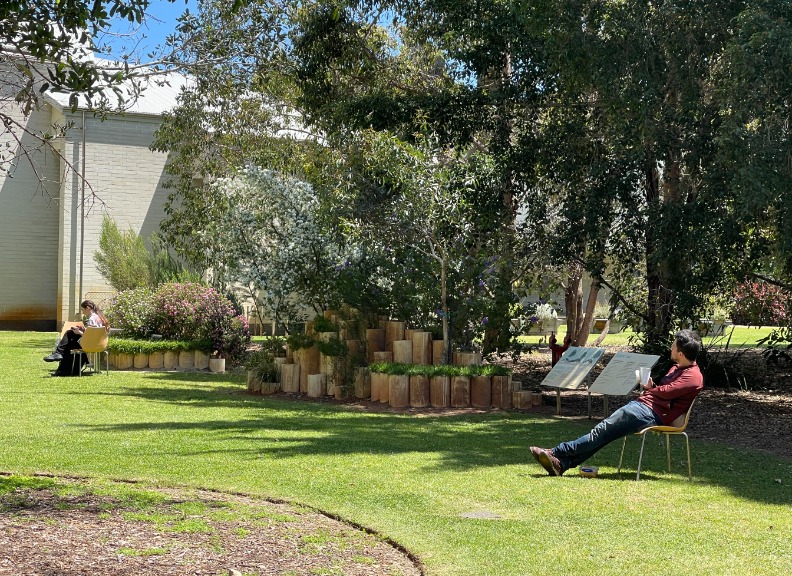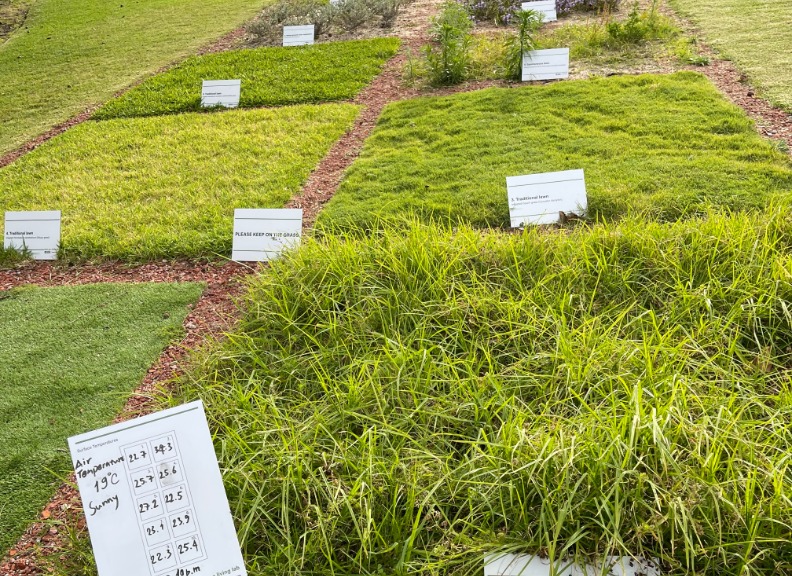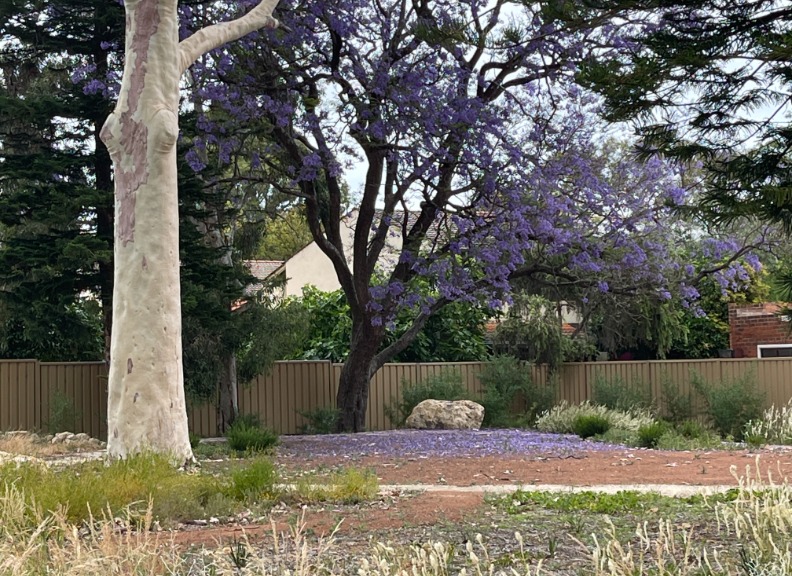PROJECT
LAWN Project
Lawn as an ecological and cultural phenomenon in Perth: searching for sustainable solutions in times of a drying climate
The project investigates the phenomenon of lawns from environmental (biodiversity), social (perceptions and attitudes), and design perspectives to test alternative sustainable design solutions (including design with native Western Australian plants) for urban green spaces in a drying climate.
The project is based on an integration of landscape design with ecological, biological and social sciences disciplines with direct connection to and the involvement of stakeholders. This project will generate new knowledge on understanding designed urban ecosystems (designed nature), such as lawns, in Australia using empirical data, innovative technologies (e.g. remote sensing), and practical implementations (living labs and demonstration trials).
Project goals:
- Evaluate existing plant biodiversity, soils and management practices (use of water, mowing, fertilisers and herbicides) of lawns in case study of public spaces (parks and street verges)
- Identify current social values and preferences of different socio-economic groups toward existing traditional lawns and lawn alternatives that introduce new species, designs and management strategies
- Develop and test a series of sustainable design and management solutions for water-wise and biodiverse lawns in a drying climate on established demonstration sites (and living labs) in public green spaces (parks, golf courses and university campuses) with community education about new and innovative solutions
Established Living Labs and Demonstration Sites
Living Lab: Shifting Sands, UWA Nedlands Campus
Living Lab 1: Shifting Sands (UWA Nedlands Campus)
Established October 2020
Living Lab: Shifting Sands, UWA Nedlands Campus
Established October 2020
Shifting Sands is a ‘Living Lab’ aimed at encouraging communal and educational activities and experiences concerning both sustainable design and Perth’s unique landscape. The design principles include: sustainability (using recycled material and low water species), biodiversity (using native Western Australian plant species), aesthetics (nature/culture coexistence) and education (interactive living lab for students, staff and visitors).
Shifting Sands received the 2021 AILA WA Landscape Architecture Award for Small Projects.
Living Lab: Lawn as a Living Lab, UWA Nedlands Campus
Living Lab: Lawn as a Living Lab, UWA Nedlands Campus | Established June 2021
Living Lab: Lawn as a Living Lab, UWA Nedlands Campus
Established June 2021
This living lab exhibits the following lawn gradient: old lawn left uncut (Couch and Kikuyu mix), artificial turf, three traditional lawn species used in Perth with conventional irrigation and mowing (Cynodon dactylon, Stenotaphrum secundatum and Pennisetum clandestinum), spontaneous lawn (abandoned ground left to natural plant succession processes) and native ground covers of Dichondra, Eremophila, Myoporum and Scaevola species.
Living Lab: Urban Biodiversity in Design, UWA Crawley Campus
Living Lab: Urban Biodiversity in Design, UWA Crawley Campus
29 Cook Street, Crawley 6009 | Established July-September 2022
Living Lab: Urban Biodiversity in Design, UWA Crawley Campus
29 Cook Street, Crawley 6009 | Established July-September 2022
The design concept is based on the demonstration of dynamic character of existing urban landscapes. The present site is a typical urban biotope that can be found anywhere in Perth. The garden shows the dramatic transformation of Perth’s landscapes from the original indigenous vegetation, Karrakatta complex, to designed colonial garden, an orchard, and a spontaneous weedy space. This journey is taken through a series of looped paths that starts and finishes with the native garden – an attempt to return native nature to the urban landscape. This garden has three mini exhibits testing mixture of native grasses and groundcovers as a part of the LAWN project.
Demonstration Site: Dowling Street Reserve, Rockingham experimental plots
Demonstration Site: Dowling Street Reserve, Rockingham experimental plot
Established June 2024
Demonstration Site: Dowling Street Reserve, Rockingham experimental plots
Established on the 4th of June 2024,
These 16 experimental plots aim to demonstrate different scenarios of sustainable options for urban lawns and investigate the phenomenon of lawns from environmental, social and design perspectives to test alternative sustainable design solutions for urban green spaces in a drying climate. Plots include mixtures of low-growing native grasses, sedges, perennials, annuals, and shrubs as well as new lawn species and maintenance specifications to help find water-wise and biodiverse solutions for Perth public and private lawns.
Experimental plots idea and methodology: M. Ignatieva
Planting design of native grass plots, plant material: D. Wittwer
Experimental plots implementation: M. Ignatieva, D. Wittwer, A. Cabanek, L. Liu, G. Fawkes, City of Rockingham team (M. Chambers, A. Johnston)
Demonstration Site: Collier Park Golf Course, City of South Perth
Demonstration Site: City of South Perth and Collier Park Golf Course plots
Established June 2024
Demonstration Site: Collier Park Golf Course, City of South Perth
Established on the 4th of June 2024
These 12 experimental plots aim to demonstrate different scenarios of sustainable options for urban lawns and investigate the phenomenon of lawns from environmental, social and design perspectives to test alternative sustainable design solutions for urban green spaces in a drying climate. Plots include mixtures of low-growing native grasses, sedges, perennials, annuals, and shrubs as well as new lawn species and maintenance specifications to help find water-wise and biodiverse solutions for Perth public and private lawns.
Experimental plots idea and methodology: M. Ignatieva
Planting design of native grass plots, plant material: D. Wittwer
Experimental plots implementation: M. Ignatieva, D. Wittwer, A. Cabanek, L. Liu, G. Fawkes, City of South Perth and Collier Park Golf Team
Demonstration Site: Western Australian Native Meadows
Western Australian Native MeadowsCollier Park Golf Course, City of South PerthEstablished June 2024
Demonstration Site: Western Australian Native Meadows
Established on the 14th of June 2024
The goal of this meadow is to try to create meadow-like vegetation based on grasses, sedges, perennial and annual native Western Australian species. This aims to test the opportunity of designing biodiversity-friendly, aesthetically pleasant plant communities that could find a place in the public parks and golf courses in dedicated open space zones. Planting methods include tube planting and sowing seeds.
Experimental site idea: M. Ignatieva
Planting design concept and plan, plant material recommendations: D. Wittwer
Experimental plots implementation: M. Ignatieva, D. Wittwer, A. Cabanek, S. Nielsen, L. Willix, M. Nastos, City of South Perth and Collier Park Golf team
Project team:
Project lead: Professor Maria Ignatevia (UWA School of Design)
Project team: Denis Wittwer, Agata Cabanek, Daniel Martin, Fahimeh Mofrad, Ashok Kumar Chaudhary, Sofie Nielsen, Michael Hughes, Louise Barton
Project Publications
- Ignatieva, M.; Dushkova, D.; Jan Martin, D.; Mofrad, F.; Stewart, K.; Hughes, M. (2023) From One to Many Natures: Integrating Divergent Urban Nature Visions to Support Nature-Based Solutions in Australia and Europe. Sustainability 2023, 15(5), 4640
- Ignatieva, M. Urban Biodiversity in Design: Living Lab 3. University of Western Australia. 2024
- Ignatieva, M.; Hughes, M.; Chaudhary, A.K.; Mofrad, F. The Lawn as a Social and Cultural Phenomenon in Perth, Western Australia. Land 2024, 13, 191
- Ignatieva, M., Nielsen, S. & Martin, D.J. Recognising lawns as a part of “designed nature”. Pioneering study of lawn’s plant biodiversity in Australian context. Urban Ecosyst 28, 137 (2025).
- Ignatieva, M.; Hughes, M.; Mofrad, F.; Cabanek, A. Challenging the Norm of Lawns in Public Urban Green Space: Insights from Expert Designers, Turf Growers and Managers. Land 2025, 14, 1814.
Sponsors
- The Turf Growers Association of Western Australia
- Turf Producers Australia
- City of South Perth (and Collier Park Golf)
- The City of Rockingham
- Department of Water and Environmental Regulations (DWER)
- Water Corporation
- Murdoch University
- ArborCarbon
- StrataGreen
- SYRINX
PhD opportunities
We welcome engaged research scholars that are driven by research led landscape design, to advance the mission of the LAWN project and be part of our interdisciplinary team of scholars and industry collaborators/ We seek in particular candidates who have a proven record of publications in the area of urban biodiversity and design research and/or practical applications of planting design.
A Bachelors and Masters degree in Landscape Architecture is desirable but we do welcome outstanding candidates from interdisciplinary relevant areas as well. A research proposal needs to be sent at the time of application with a list of publications relevant to the proposal. Please check UWA requirements for PhD entry, as these are deemed essential.
Contact
Professor Maria Ignatieva
Phone
08 6488 2789






